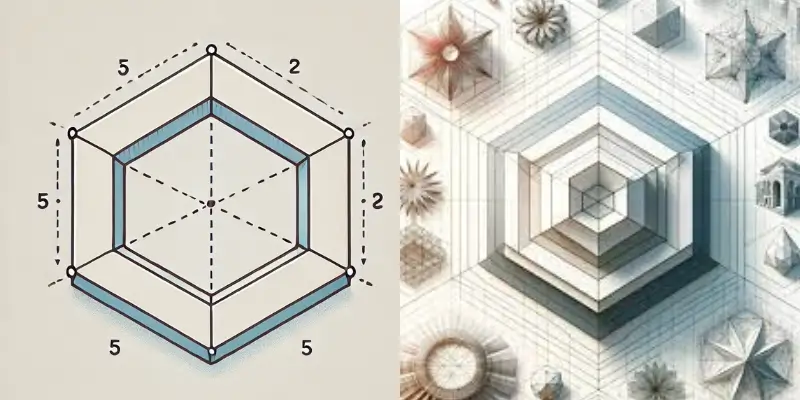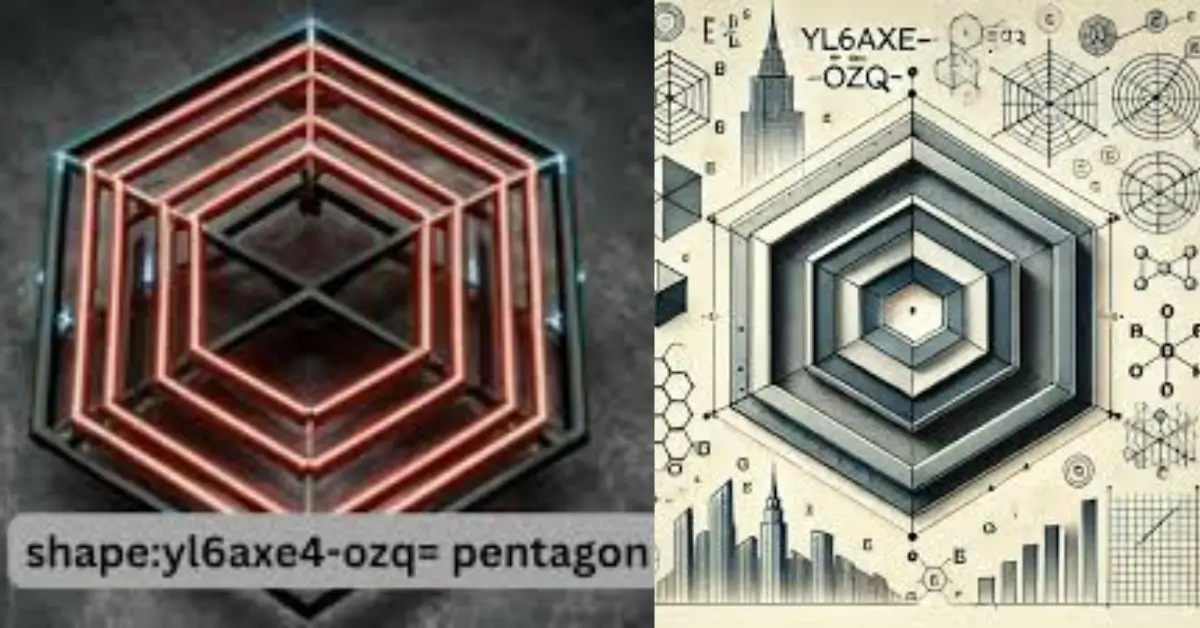shape:yl6axe4-ozq= pentagon stands out in geometry for its unique five-sided structure, symmetry, and diverse applications across fields like architecture, data structures, and even natural patterns. This article dives into the pentagon shape, its mathematical properties, various classifications, and how it appears in real-world scenarios.
Our goal is to build a sense of trust and excitement by exploring the full depth of this timeless polygon. Whether you’re an enthusiast of geometry, a professional in software design, or simply curious, this in-depth look at the Shape= Pentagon will highlight why the pentagon shape captivates scholars and designers alike.
Let’s dive into the wonders and applications of the pentagon and discover why this five-sided polygon remains an enduring part of geometric studies.
Overview of the shape:yl6axe4-ozq= pentagon
The term Shape= Pentagon might seem unusual, but it represents more than just a five-sided figure. Here, “yl6axe4-ozq” likely serves as an identifier in a specific context or software, designating a unique instance of a pentagon for use in modeling, architecture, or data structuring. This article will explore all facets of this identifier and its practical significance.
In essence, a pentagon is a five-sided polygon where each corner (or vertex) connects two sides. This geometric form is known for its simplicity and symmetry, as well as its ability to adapt to multiple applications, making it invaluable in fields such as architecture and software.

Understanding the Pentagon as a Geometric Shape
The pentagon is classified as a polygon in geometry due to its five sides. Regular pentagons, in which all sides and angles are equal, are particularly admired for their symmetry. With each interior angle measuring precisely 108 degrees, the regular pentagon is a fascinating shape that combines simplicity with mathematical elegance.
When irregular, the pentagon’s shape changes based on the length of its sides and the measure of its angles. However, regardless of these variations, the pentagon’s core characteristic – having five distinct sides – remains unchanged, offering a unique foundation for various polygons in geometry.
Read Also: Contactsjet. shop
Properties and Characteristics of a Pentagon
A pentagon shape is defined by a few key properties: five sides, five vertices, and specific angle measures. For regular pentagons, the sum of interior angles totals 540 degrees, making each internal angle 108 degrees. The simplicity and balance of this structure make it one of the most recognizable shapes in polygon classification.
Another key characteristic is pentagon symmetry. A regular pentagon exhibits rotational symmetry, meaning it can rotate around its center and still look the same. This symmetry not only makes the pentagon visually appealing but also provides structural advantages in designs and architecture.
Types of Shape= Pentagon in Geometry
Pentagons come in various types, primarily divided into regular and irregular pentagons. A regular pentagon has all sides and angles equal, while an irregular pentagon varies in both dimensions. These differences allow the pentagon to take on numerous roles, from straightforward geometric exercises to complex architectural designs.
In terms of classification, pentagons can also be concave or convex. Convex pentagons, like the regular type, have vertices pointing outward, whereas concave pentagons have at least one vertex that points inward. This diversity enables pentagons to serve as adaptable building blocks in many geometric and real-world applications.
Applications of Shape= Pentagon in Real-Life Examples
The Shape= Pentagon finds practical applications in multiple fields. Its five-sided structure is commonly seen in architecture, where pentagon-inspired structures offer visual appeal and structural integrity. The Pentagon building in the United States, one of the world’s largest office buildings, is an iconic example of this application.
In nature, pentagonal patterns can also be found, notably in organic structures like flowers and sea stars. These pentagon applications in nature emphasize the shape’s versatility and natural appeal, making it both a functional and aesthetically pleasing choice in design.
Mathematical Formulas Related to Shape= Pentagon
Calculating the area of a regular pentagon involves the formula:
Area=145(5+25)×s2\text{Area} = \frac{1}{4} \sqrt{5(5 + 2\sqrt{5})} \times s^2Area=415(5+25)×s2
where sss is the side length. This formula reveals the beauty of mathematics and geometry by translating a simple shape into a precise measure, which is essential for practical uses in design and architecture.
Another important formula is the perimeter calculation, which is straightforward for regular pentagons. By multiplying the side length by five, designers can quickly determine perimeter values needed in various applications.
Exploring Shape= Pentagon Angles and Symmetry
Angles in a pentagon shape are crucial for its symmetry. In a regular pentagon, each interior angle measures 108 degrees, creating a balance that makes it visually appealing and structurally efficient. This symmetry is leveraged in architectural designs, allowing structures to stand firm and stable.
Pentagon symmetry isn’t limited to regular shapes. Irregular pentagons can also maintain a form of symmetry, particularly in applications where stability is prioritized. This adaptable symmetry is one reason pentagons are favored in various structural applications.
Identifying Shape= Pentagon in Various Contexts
Shape identifiers like “yl6axe4-ozq” might be unique to particular software or databases, where shapes are cataloged for design and modeling purposes. This identifier ensures that the pentagon instance can be referenced precisely in digital platforms, enhancing consistency and accuracy in architectural and software design.
Whether it’s for architectural modeling, geometry studies, or digital design, the Shape= Pentagon identifier helps professionals manage complex datasets and keep track of shape instances across projects.
Shape Identifiers: The Meaning of yl6axe4-ozq=
The identifier “yl6axe4-ozq” might indicate a coding format used in software to categorize or reference specific shapes. Such identifiers simplify the task of distinguishing between shapes, especially in complex databases or design software where multiple polygons are employed.
This labeling system allows for precision, enabling designers and engineers to reference specific shapes accurately. In this context, shape identifiers like “yl6axe4-ozq” play a crucial role in maintaining consistency and efficiency in design and data management.
Polygons and Their Classification in Geometry
Polygons are shapes with three or more sides, and they’re classified based on the number of sides and angles they contain. The pentagon (shape) falls into the category of five-sided polygons and is highly valued for its versatility and symmetrical properties.
By understanding polygon classification, students and professionals alike can appreciate the diversity within geometric shapes and how they relate to each other, ultimately aiding in more effective design and modeling strategies.
Pentagons in Software and Data Structures
In software, pentagons may be represented as data points or geometric identifiers for modeling. These pentagon identifiers in software allow designers to create complex shapes, simulate structures, and analyze design properties, making it easier to visualize and manipulate pentagonal forms.
Applications for pentagons in software range from architectural simulations to graphic design tools, where pentagon shapes serve as core elements in larger compositions. The Shape= Pentagon identifier is a useful example of how shapes are managed in digital environments.
The Role of Shape= Pentagon in Architectural Design
The pentagon shape’s stability and symmetry make it popular in architectural design. One well-known example is the Pentagon building in Virginia, which uses the pentagon shape to optimize space and symbolize strength and unity. Such designs highlight the shape’s structural and aesthetic benefits.
Architects often incorporate pentagonal structures in floor plans or decorative elements, as the five-sided symmetry is both functional and visually striking, showing the value of the pentagon (shape) in construction.
Significance of Shape= Pentagon in Nature and Art
Pentagons appear naturally in various forms, including flowers, fruits, and sea stars, showcasing the shape’s organic appeal. This significance of the pentagon in nature emphasizes the shape’s harmony and elegance, making it an inspiration for artists and designers alike.
In art, pentagonal patterns can add complexity and depth, transforming simple shapes into mesmerizing designs. The pentagon’s adaptability demonstrates how geometry and aesthetics intersect, inspiring creations in multiple forms.
Understanding Pentagon Perimeter and Area Calculations
Calculating the pentagon perimeter is straightforward: multiply the side length by five. This calculation is essential for architects and engineers who need precise measurements for designing structures based on pentagonal shapes.
For the area of a regular pentagon, the formula mentioned earlier simplifies this calculation, giving professionals the tools to incorporate pentagons effectively in blueprints and models.
Real-World Examples of Shape= Pentagon Usage
In addition to its architectural significance, pentagons are used in jewelry design, artistic patterns, and even in tiling. These real-world examples showcase the pentagon’s versatility and its ability to enhance aesthetic appeal while providing structural integrity.
Another notable example is the use of pentagons in game design, where they can add variety to environments, proving that the pentagon shape is as functional as it is beautiful.
Read Also: Timberwolves vs Dallas Mavericks Match Player Stats
Quick Facts
- Five sides and vertices: The defining characteristics of a pentagon.
- Interior angles: Regular pentagons have interior angles of 108 degrees.
- Symmetry: Regular pentagons are rotationally symmetric.
- Applications: Architecture, art, software modeling, and more.
Final Thoughts
The Shape= Pentagon is a remarkable geometric figure, beloved for its symmetry, functionality, and beauty. Its presence in nature, art, architecture, and software underscores its universal appeal, making it an enduring symbol of design and balance.
FAQs
What is the significance of the Shape= Pentagon?
This identifier might be unique to certain software or design databases, allowing for specific referencing of pentagonal shapes in various fields.
How is the area of a pentagon calculated?
For regular pentagons, the area is calculated with the formula 145(5+25)×s2\frac{1}{4} \sqrt{5(5 + 2\sqrt{5})} \times s^2415(5+25)×s2, where sss is the side length.
Where are pentagons commonly used?
Pentagons are used in architecture, software design, nature-inspired art, and structural engineering due to their symmetry and strength.
